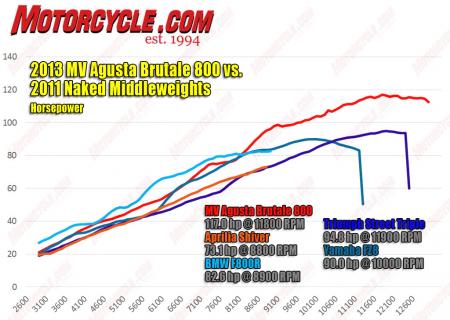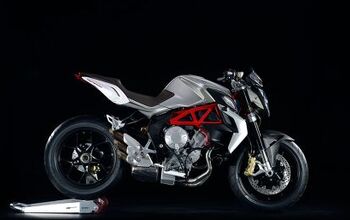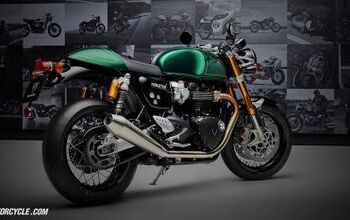2013 MV Agusta Brutale 800 Review - Motorcycle.com
I have a long history of saying that pretty much every engine could be improved by adding 10% more power. With the Brutale 800, MV Agusta has achieved that goal and then some.
Flush, at least temporarily, with Harley-Davidson cash, MV developed a new line of three-cylinder engines to bring smaller-displacement and less expensive models to market. First to arrive was the 675cc F3 supersport that builds from the successful formula Triumph has utilized with its Daytona. Priced at $13,998 and blessed by features such as a counter-rotating crankshaft for quicker steering and high-tech electronics like a ride-by-wire throttle and traction control, it enabled a step into the esteemed MV Agusta brand with a paltry-ish $1300 price premium over its English competitor, the Daytona 675R, one of our favorite sportbikes.
TRIPLE POWER: 2013 MV Agusta F3 675 Review - Video
Next up was the Brutale 675, a streetfighter-styled sportbike using a retuned version of the F3’s Triple. Although claimed crankshaft horsepower dropped from 129 to 109, our Euro correspondent gave it high marks for its potent lunge in all street situations within his review from last summer. It also is relatively affordable, with a list price of $10,998; add another $500 for EAS (Electronic Assist Shift). Its natural competitor is also from Triumph, the impressively fun and revised-for-2013 Street Triple R ($9999).
But perhaps you’re the kind of rider who considers 675cc on the small side for their ultimate naked sportbike. Enter the Brutale 800, an offshoot of the B675 but with 123 extra cubes. The additional displacement is realized via an 8.4mm increase in its stroke. Very little else changed, as it uses the same valve sizes and throttle bodies as its little brother. Compression goes up from 12.0:1 to a stratospheric 13.3:1. MV claims both three-cylinder Brutales scale in “dry” at an identical 368 pounds. Its actual curb weight likely approaches the 400-pound mark.
LITTLE BROTHER: 2012 MV Agusta Brutale 675 Review
Power output jumps from a factory-rated 109 hp at 12,500 rpm to 125 hp at 11,600 revs, a significant increase of 14.7% produced almost 1000 revs sooner. That’s a healthy boost in ponies, but even more impressive is the B800’s escalation of torque. The B675 is rated at 48 ft-lb at 12K rpm, while the 798cc version twists its way to 60 ft-lb a massive 3400 rpm sooner. Thus, the bigger Brute enjoys a torque peak 25% greater than its little brother!
While we’re geeking on math, here’s one other important figure: When identically equipped with EAS (standard on the $12,498 B800), the huge bump in power will cost just 8.7% extra.
Stop The Math! How Does It Perform?
Quite ferociously, thank you! The Brutale 800’s eagerness to romp is nothing short of intense. Timid riders should keep their distance. With its tight 54.3-inch wheelbase and reasonably low 31.9-inch seat height, MV’s middle Brutale feels like a compact middleweight when straddled. But it only takes one twist of its short-turn throttle to realize you’re on a machine that can outmuscle many liter-size naked sportbikes.
Like all MV Agustas, the three-cylinder Brutales are richly detailed and delight the eyeballs. Visual entertainment lurks around every corner and curve of the Italian sculpture. It starts with red steel-trellis bridgework that frames the engine and joins to a cast-aluminum structure that supports the single-sided swingarm.
Finer details are found in smaller places. Note the flowing swoosh on the lower fork legs that commingle in the brake caliper mounts, or the graceful slashes formed in the front fender. Or the characterful creases adorning the classy titanium-colored 4.4-gallon fuel tank and the graceful and tidy tail section.
The Brutale’s only fashion faux pas are related to emissions regulations. The emissions-compliance sticker on left fork tube looks heinous, while you can blame the California Air Resources Board for the black plastic evaporative canister stuck to the left side of its engine.
Additionally, our Content Editor, Tom Roderick, found stylistic fault with some of the bike’s exposed plumbing. “The rear brake lines and vacuum tubes around the right footpeg are an ugly mess for a motorcycle company with a self-proclaimed ‘motorcycle art’ moniker,” he decried.
Firing up the Brutale’s powerplant reveals a vibey powerplant, exhibiting a coarse nature beyond the 675cc Triples we’ve sampled despite a counterbalancer. It feels gravely at idle, especially with the clutch released, and its buzzier also at its high end. The stroker engine picks up revs quickly, displaying what seems like a light flywheel.
The Brutale’s ergonomics are nearly ideal for a streetfighter, placing its rider into a ready-for-action posture without forcing too much weight on wrists. Its seat is fairly narrow at the tank junction, which compromises support but offers feet an easy reach to the ground. Tall riders may wish for more legroom or that the seat didn’t slope upward at its rear. The front brake lever boasts a fancy adjustable-reach design to accommodate hands of various sizes, but the clutch does not.
Before takeoff you may want to select the ride mode that suits you best. I’d recommend Normal mode, as its throttle response isn’t as deliberately sharp as Sport. Rain modes are typically useless unless it’s raining, but we enjoyed finding out that MV’s wet setting still fields strong enough power to allow wheelies unlike TC systems that employ front wheel-speed sensors.
The Brutale dices up urban traffic with aplomb. Steering responses are ultra-quick, and the upright-ish riding position helps a rider plot a course around cage drivers. The MV’s deep well of power is an asset even when crawling around city streets, dished out capably by a cable-actuated clutch. MV gave the B800 taller gearing than the 675, although the fierceness of its acceleration belies those specs. Wheelies are a constant threat. Imagine a Triumph Street Triple with an extra 25 hp and a wheelbase more than an inch shorter.
THE COMPETITION: 2012 Ducati 848 Streetfighter Review - First Ride
Riding smoothly at small acceleration rates can be hindered somewhat by the B800’s standard-equipment electronic quickshifter, as clutchless upshifts in the first two gears occur with some abruptness. Best to use the clutch when upshifting at low throttle openings, as the MV is unable replicate the seamlessness of Triumph’s quickshifters. It does, however, work fabulously when grabbing full-throttle upshifts.
Freeway manners are quite good for a naked sportbike. The moderate reach to the bars is countered by wind pressure from highway-speed air hitting chest level. A firm seat and relatively high footpegs will induce some squirming after an hour or so. Views of traffic behind are compromised by mirrors placed on an intersecting path with a rider’s arms. Best practice is to make use of the Brutale’s incredibly potent midrange power and simply accelerate away from offending traffic. How potent? The 800cc Brute walked away from a 1000cc F4RR during a 75-mph roll-on contest.
The Brutale’s fully adjustable suspension feels well sorted for street applications. The 43mm Marzocchi fork has compression adjustments at the top of the left fork leg and rebound in the right, so there’s no need to get on your knees to change their settings. The Sachs shock is also well-tuned, requiring only a half-turn additional rebound damping to tame rear-wheel motions when ridden aggressively in the canyons.
And it’s in the canyons where the Brutale 800 shines brightest. Turn-in response is exceedingly quick, giving the MV unparalleled agility for a bike of its size. The use of a 180/55-17 rear tire, rather than a fashionably fat 190, along with the lessened gyroscopic effect from its counter-rotating crank, gives the Brutale a nimble feel not far removed from the incredibly playful Street Triple.
Those whispers of instability turned into a scream in one instance while riding on a SoCal freeway. To get around a clog of traffic, I accelerated hard from 70 mph while traveling over some Botts dots that divide lanes on our freeways. While enjoying the engine’s instant thrust, the handlebars unexpectedly began wagging in my hands and nearly caused me to pee my pants as I contemplated if the bike would spit me off. While not a full lock-to-lock tankslapper, it gave me such a fright that it made me uneasy every time I dialed up full throttle. I’d factor in the cost of a steering damper if I was considering a Brutale 800.
MORE MV: All Things MV Agusta on Motorcycle.com
Power to inhale straights is never in question. It’s worth noting that the Brutale 800 produces peak horsepower nearly on par with Kawasaki’s Z1000 and Triumph’s Speed Triple while carrying around 70-plus pounds less weight.
The Difficult Pursuit of Perfection
So, add a steering damper and the Brutale is perfect, right? Well, not quite. MV’s ride-by-wire throttle needs further tuning to deliver optimum throttle response. It’s as if the twistgrip isn’t directly linked to the engine, which, being a R-b-W design, it isn’t. A light throttle-return spring amplifies this ambivalence.
Conclusion
The Brutale 800 is one of the most exciting naked sportbikes ever made, and its handsome style will impress at the Burger Barn or just sitting quietly in your garage. As such, it’s one of the most desirable nakeds in production.
But it’s not without its flaws. We absolutely love its engine, but its engine-management behavior needs further development – hopefully an issue that updated ECU mapping will solve. Adding a steering damper would be an easy fix for the Brutale’s stability issues.
Yet the combination of its size, its power and its style makes it distinct among its streetfighter brethren. The only thing that comes close is Ducati’s 848 Streetfighter. An Italian Middleweight Streetfighter Comparo is sure to follow.
At $12,498, the Brutale 800 is inexpensive relative to other MV Agustas, putting it within range of enthusiasts who could previously only dream about MV ownership. It’s a scintillating machine that balances real-world usability with improbable sporting prowess and chic Italian style.
Related Reading
2012 MV Agusta Brutale 675 Review
2013 MV Agusta F3 675 Review - Video
2012 Ducati 848 Streetfighter Review - First Ride
2012 European Streetfighter Shootout: Aprilia Tuono V4R vs MV Agusta Brutale 1090R vs Triumph Speed Triple R
2011 Streetfighter Shootout: Honda CB1000R vs Kawasaki Z1000 vs Triumph Speed Triple
All Things MV Agusta on Motorcycle.com
More by Kevin Duke








































Comments
Join the conversation